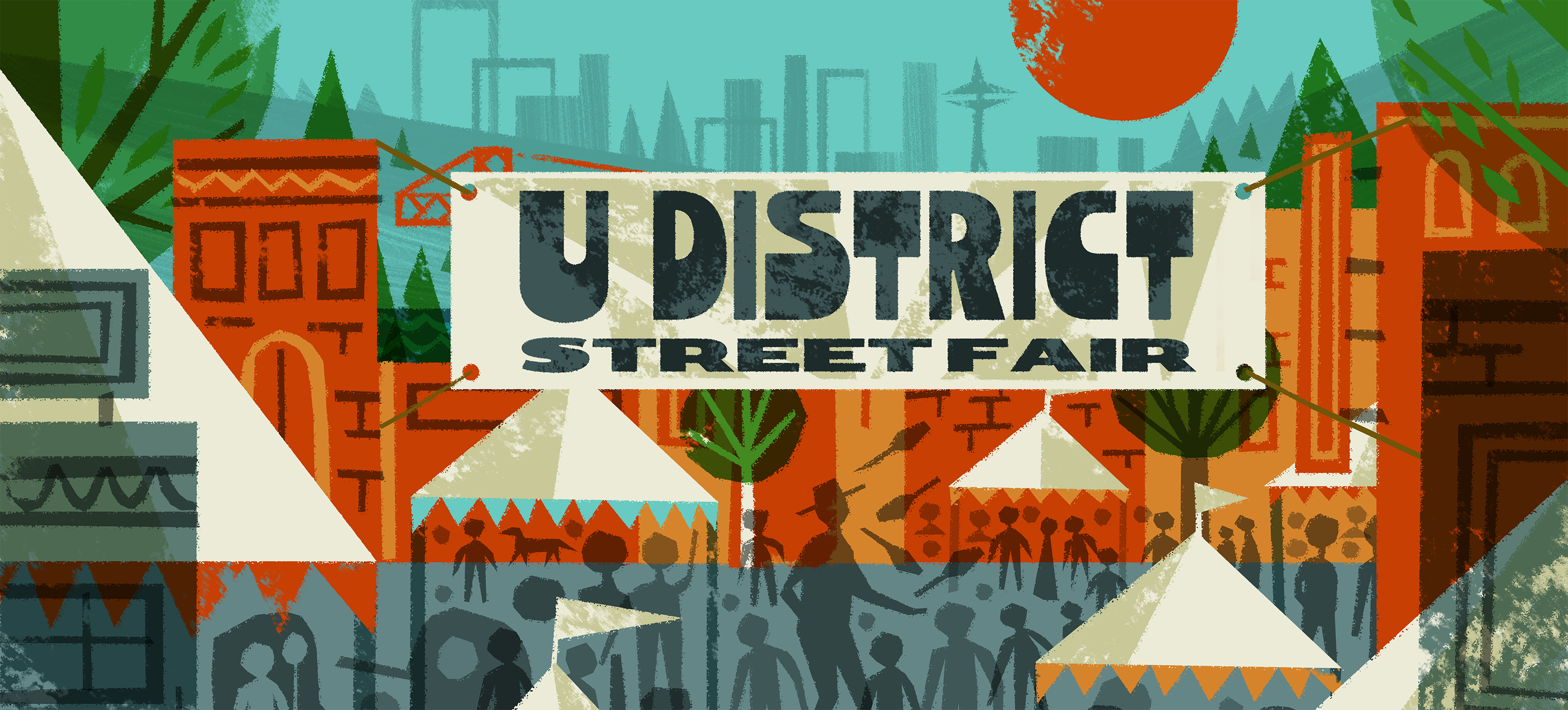THE HISTORY OF THE U DISTRICT STREET FAIR
Since 1970, the U District Street Fair has brought our Seattle community together to showcase artists and craft vendors while highlighting the creativity that flourishes in Seattle’s University District. Now celebrating its 55th year, the U District Street Fair is the longest running festival of its kind west of the Mississippi. As we prepare to gather together again on “the Ave,” we find ourselves in surprisingly similar circumstances to fairgoers over 50 years ago.
The Street Fair was born in an era where calls for social justice and the end of the horrors of wars around the world were coupled with economic turbulence and major physical changes to the University District. Community leaders hoped the Street Fair would harness the local creative energy of artists to encourage community members to cross out of their comfort zones to better understand different perspectives. Today, many of these same themes are at the forefront of community conversations and we continue to believe that a street fair focused on art, creativity and bringing people together can build community.
A U DISTRICT TRADITION, ROOTED IN CHANGE
The University District served as north Seattle’s vibrant main street for the first half of the 20th Century, with a variety of department stores, boutiques, restaurants, movie palaces and concert halls. By the late 1950s, Interstate 5 construction forever changed the landscape and access to the University District. Much like the opening of the U District light rail station in 2021, access to a new regional transportation system brought hope of increased economic activity, as well as new competition from other regional shopping destinations like Northgate Mall, which had opened in 1950. The opening of the University Village in 1956, on the site of a former city landfill, also began to pull economic prosperity from the Ave. The U District business community responded to this new competition by promoting the concentration of stores on the Ave as a “department store eight blocks long,” but change was omnipresent.
The 1960s brought more change that would have a profound impact on the U District. The national civil rights movement and calls to end the war in Vietnam also took center stage during this decade with the U District serving as a hub for major demonstrations. In 1968, the Tet Offensive and the tragic assassinations of Dr. Martin Luther King, Jr. in April and Robert F. Kennedy were acutely felt in Seattle. The U District saw major demonstrations continue into 1970 with over 1,000 students marching from the U District to shut down Interstate 5, following the United States’ invasion of Cambodia and the killings of four demonstrating students at Kent State University in Ohio. It was against this tumultuous backdrop that the U District Street Fair was born.
ANDY SHIGA’S VISION AND IMPACT ON THE U DISTRICT
In 1959, Japanese American merchant Andy Shiga (1919-1993) opened Shiga’s Imports at 4306 University Avenue, which offered one of the few Asian import stores outside of the International District. In addition to his import business, Andy Shiga also was a dedicated peace activist who cared deeply about what he was seeing around him, endeavoring for positive change and healing. As political turbulence escalated in the late 1960s, Mr. Shiga, along with lawyer and unofficial U-District mayor Cal McCune, Safeco executive Ron Denchfield, and other members of the University District Chamber of Commerce met with activists, students, and other constituents to better understand the different perspectives of U District stakeholders and to attempt to bring the community together.
It was Mr. Shiga who, while jogging, first conceived of an arts-centered festival event to relieve some of the tension and discord prevalent throughout the neighborhood and manifest it on the Ave. Possibly drawing inspiration from a large experimental street concert that took place on the Ave in 1968, called “The Great Love U”, Mr. Shiga looked to harness the creative energy of local artists, artisans, craftspeople, and business owners to encourage community interaction. As Mr. Shiga explained in a Seattle Times article, “We are having this fair to create one small situation in which people will be encouraged to cross over various social and psychological barriers to stimulate the growth of openness, humor, love and compassion amongst people, which is the real basis for a reactionary, free and healthy world.”
IN 1970, A STREET FAIR IS BORN
The University District Chamber of Commerce held Seattle’s first modern street fair on May 23 and 24, 1970. First known as the ‘U District Sidewalk Fair’, the event closed The Ave to traffic from NE 50th Street to NE 41st Street and was largely produced by volunteers. Over the course of the weekend, 50,000 people visited stalls and tents set up by 300 vendors and artists. The event was officially opened by Mayor Wes Uhlman and featured an ambitious arts-focused agenda that included art shows all over the neighborhood, from a photo exhibit at a community bank, to an Art Mart at the University Bookstore, as well as an art masters’ thesis show at the Henry Art Gallery. The festival also featured continuous music throughout the weekend, including dance performances from around the world and bands playing everything from chamber music to bluegrass and jazz.
The fair returned in May 1971, expanding to 600 vendors. With sunny weather and a variety of music and activities, the fair included photography exhibits, a drama stage, puppet shows, and glass-blowing by UW students. In 1972, the fair swelled with 130,000 visitors. In 1973, KOL-FM broadcast live from the fair on the corner of N.E. 43rd and The Ave. By the mid-1970’s, several other Seattle neighborhoods, including Pike Place Market, Fremont, and Wallingford, started hosting their own street fairs.
The U District Street Fair’s popularity reached a point where vendors far outnumbered available space, so a lottery was established to provide more equal opportunities to participate. It was reported in 1972 that one craftsperson made one fifth of her total income selling products over 2 days at the fair.
Additional activities included a hot air balloon providing vertical rides in 1974, and in 1977, a circus theater called the Floating World Circus. This circus theater was developed by Greg Albert, an instructor with the University of Washington Experimental College. A 16-member troupe entertained fairgoers with juggling, fire-eating, acrobatics, stilt and tight-rope walking, and performances on unicycles dressed in period Renaissance costumes.
THE U DISTRICT STREET FAIR LEGACY CONTINUES
Mr. Shiga passed away in 1993, but the spirit of the U District Street Fair has continued. Original Fair co-director Susan Harris, who sold handmade sun bonnets and was known as Susie Sunshine, said, “Our goal has been to keep it the same old fair.” A reflection of the eclectic nature of the Ave, the Street Fair has been a welcoming space for children and adults alike. Children continued to have the opportunity to rent a discounted booth to sell their items.
In 2000, the fair included a lindy hop and swing dance theme, with a competition at the UW HUB Ballroom, and dancers traveling in from California and Oregon.
In 2006, in recognition of the Chinese Year of the Dog, the theme celebrated dogs with canine costume contests and booths for fairgoers to meet Seattle Police Department’s K-9 unit, the Seattle Fire Department’s arson dog, Summit Assistance Dogs, and Mishka, the Department of Fish and Wildlife’s Kraelian bear dog.
THE STREET FAIR RETURNS
In 2022, the U District Street Fair returned after a pandemic-related two year hiatus, with the added advantage of the new U District Station, Sound Transit’s busiest light rail station, letting visitors out right into the heart of the event. The fair also featured U District businesses participating in the festival footprint, many for the first time, including Shultzy’s, Big Time, Earl’s, Boba Up, Oasis Tea Zone and others.
Today, the U District Street Fair celebrates a neighborhood that is undergoing massive change on a scale not seen for over 100 years. UW is beginning to develop the West Campus along the waterfront. Twenty new towers are under development north of N.E. 41st, promising to bring thousands of new residents and office workers to the U District–many of whom will access the new U District Station that connects us to the region.
The 2026 U District Street Fair will host one of the largest vendor counts to date with over 300 artist, craft, and food vendors lining University Way NE, in addition to local participating businesses, non-profits, and more. Produced by The U District Partnership in conjunction with Bold Hat Productions, the U District Street Fair continues to mark the kick-off of festival season in the region.
Alfred Shiga, Andy’s son, recalled his purpose statement for the event at the 50th anniversary in 2019: “His idea for the Fair was meant to be a celebration of community, a showcase of local arts and crafts talent and a way to help create a bridge between all peoples that make the University District and the City of Seattle such a great place to work, to learn and to live.” As we recognize the incomparable value of community meeting in person once again, we help realize Mr. Shiga’s original vision for the Fair and the U District.


